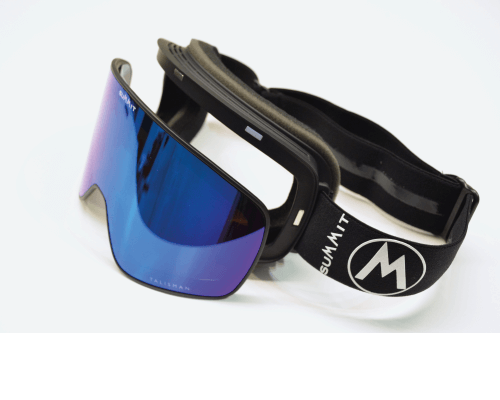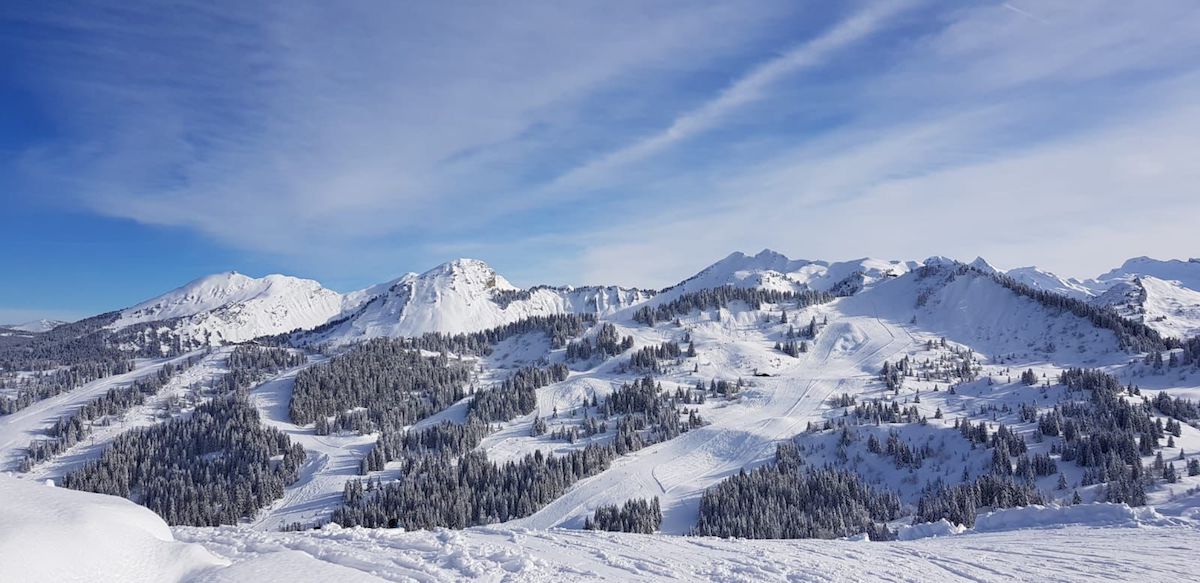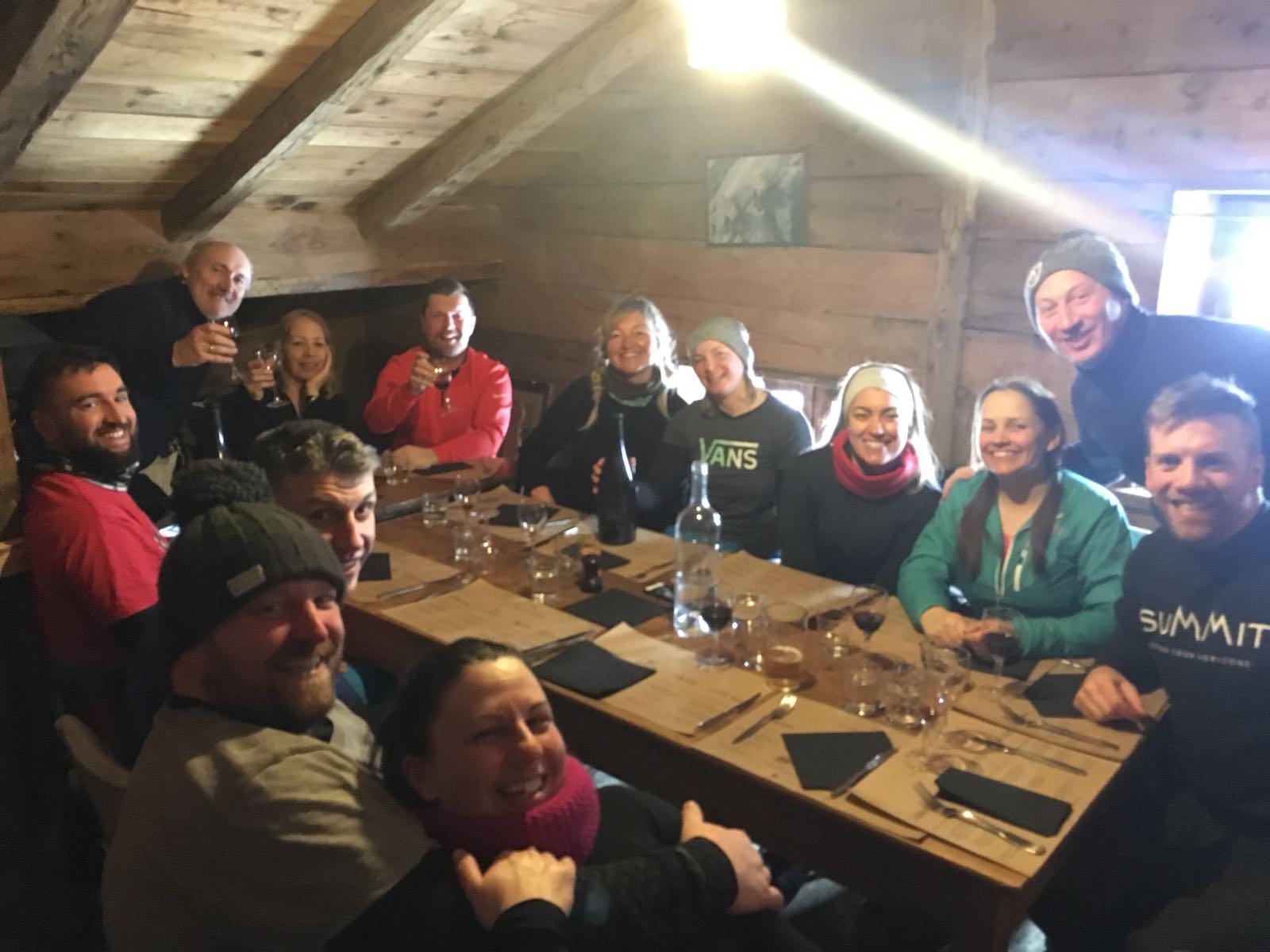If you’re just about to experience the beautiful mountains for the first time, you’re about to begin one of the most rewarding journey’s you can take yourself on. A journey, which in my opinion, will provide you with some of the most beautiful and incredible experiences you’ll ever have.
However, your first couple of weeks skiing or snowboarding are likely to be tough.
The unknown of what clothing and equipment to wear for any given day, putting ski boots on for the first time, walking in ski boots, carrying your skis whilst walking in ski boots for the first time, negotiating the first bubble lift up… and then there’s strapping a set of skis to your feet and pointing yourself down a snowy mountain, which is arguably one of the most unnatural and terrifying things you can put yourself through!
But, don’t let this put you off, because once you’re there, ‘there’ being upright and negotiating blue runs and red runs safely, you can explore almost any resort and experience some of the most staggering scenery nature has to offer at you… and these experiences then become endless.
After a day on the slopes you’ll return to a cozy warm chalet with log fire, to share a meal and a glass of red with friends and family, exchanging stories from the days adventures. Bliss.
At Summit we design and package each pair of goggles to make life as easy as possible for you. The less you have to think about, the more you can focus on your skiing. So here is some information to help you choose your all essential ski and snowboard goggles.
Anatomy of a Snow Goggle – The Basics
Let’s keep things mega simple, the green run of information if you will…
A pair of ski goggles consists of three parts: the frame, the lenses, and the strap. The lenses protect your vision and are arguably the most important component of the goggles. The frame holds the lenses in place and provide ventilation to prevent them from fogging up. They should be comfortable and not cause discomfort or pressure points. The strap secures the frame to your face and holds the goggles securely in place.
Summit Talisman – Cylindrical lens shape, with magnetic lens change system
Face Foam
Make sure the 3-layer foam follows the curvature of your face without causing pressure points. There should be no gaps between the 3-layer foam and your face for wind or snow to flow through. You want a consistent, snug fit all around the perimeter of the goggle. If the goggles pinch your face or feel uncomfortable, they probably aren’t for you.
Strap
Ski & snowboard goggles have an adjustable goggle strap, sometimes with a clip or a buckle; you should be able to tighten or loosen the goggle strap so you get the right fit on your head. If you can tighten your strap all the way and it’s still too loose, the goggles will not work for you. Keep in mind that wider straps are much easier to adjust and tend to stay put much better.
Goggle Venting
Venting is essential for air flow to circulate through the ski goggles helping to keep them fog free. Foam lining secured to the vents prevents snow and other particles entering the ski goggles whilst still allowing the air to pass through. In order to avoid misting your vents should remain clear and dry where possible. On our premium Summit Talisman goggle you’ll find the foam protected by armoured venting, this eliminates the risk of damage to the foam, or you poking your finger through the vent when putting on or taking off your ski goggles.
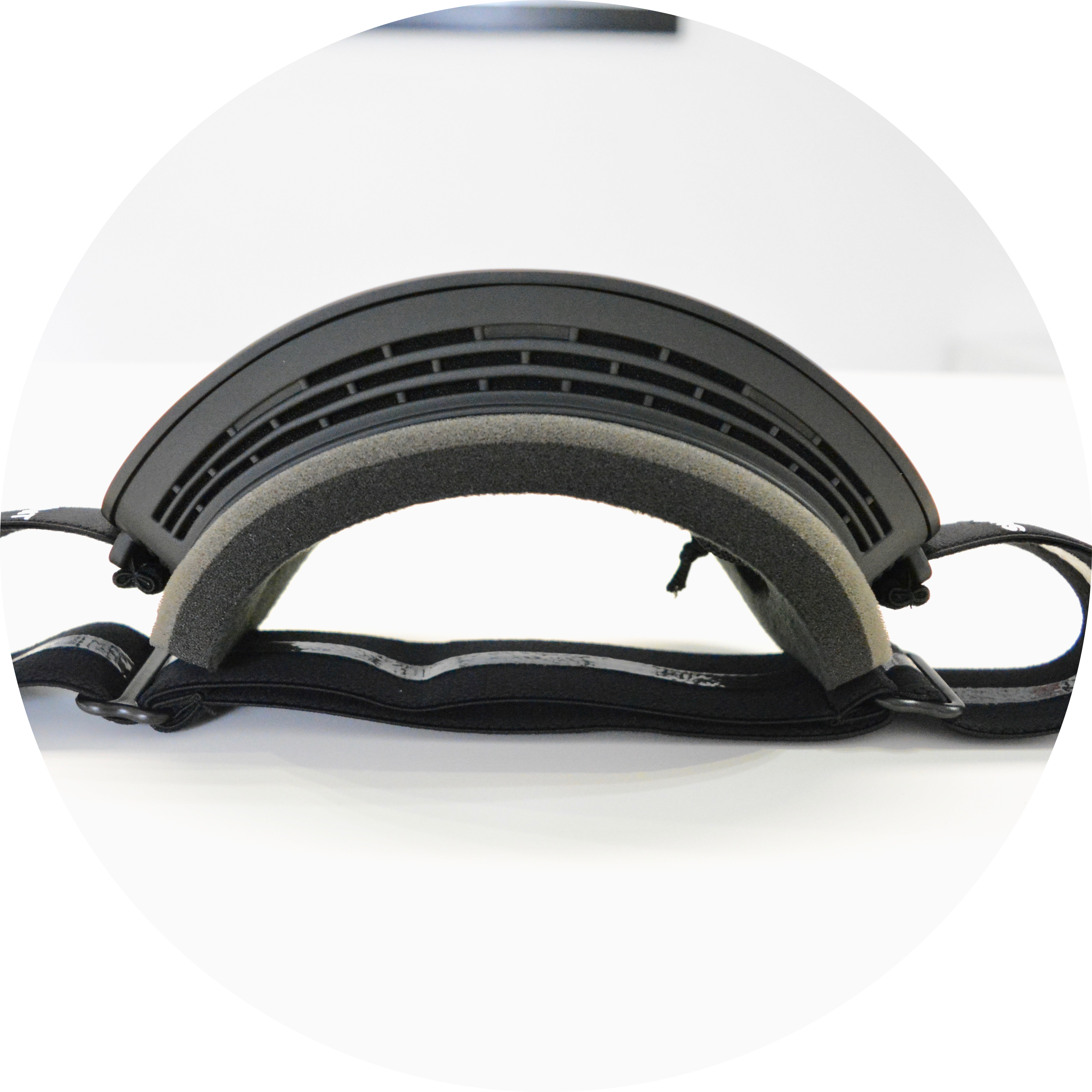
Summit Talisman Ski Goggles, with magnetic lens change system (Armoured venting and 3-layer foam)
Keen to learn a little more?
Then keep reading! Here’s the blue run of information…
Protection against ultraviolet (UV) rays
The ski goggle lens prevents damage to your eyes by protecting them from the sun’s rays and filtering 100% of the harmful UV rays. The intensity of the sun’s rays increases with altitude and so does the snow glare. Protecting your eyes is therefore essential.
A UV400 coating is applied stopping harmful sunlight from entering the eyes. The name UV400 stands for ultraviolet (UV) 400 nanometer (nm), meaning that it stops the UV rays up to wavelengths of 400nm. Your goggles should have a CE mark to highlight they meet EU specifications.
Cylindrical (Flat) Lens Goggles
We offer two different lens shape; cylindrical and spherical. The surface of cylindrical lenses are curved on the horizontal axis only, wrapping securely around the face while remaining flat vertically. Cylindrical lenses have a more retro aesthetic and we’ve seen a return to popularity in recent years. See our Summit Talisman and Velocity goggles,both of which have interchangeable lenses
Cylindrical lenses sit closer to your face due to the shape of the goggle lens, providing a large field of vision enabling you to see more of the mountains. There’s an argument that cylindrical lenses could reduce the space for air to flow, but with the correct venting and anti-fog technology you shouldn’t experience any issues. The anti-fog is embedded into the inner Cellulose Acetate cylindrical lenses on our Talisman and Xpose II range, meaning it cannot be rubbed off… premium features for premium ski goggles.
Cheaper cylindrical lenses are manufactured from large thin sheets of polycarbonate, which are stamped out and bent into a polyurethane frame. This production technique can produce distortion in the lens and increase eye fatigue.
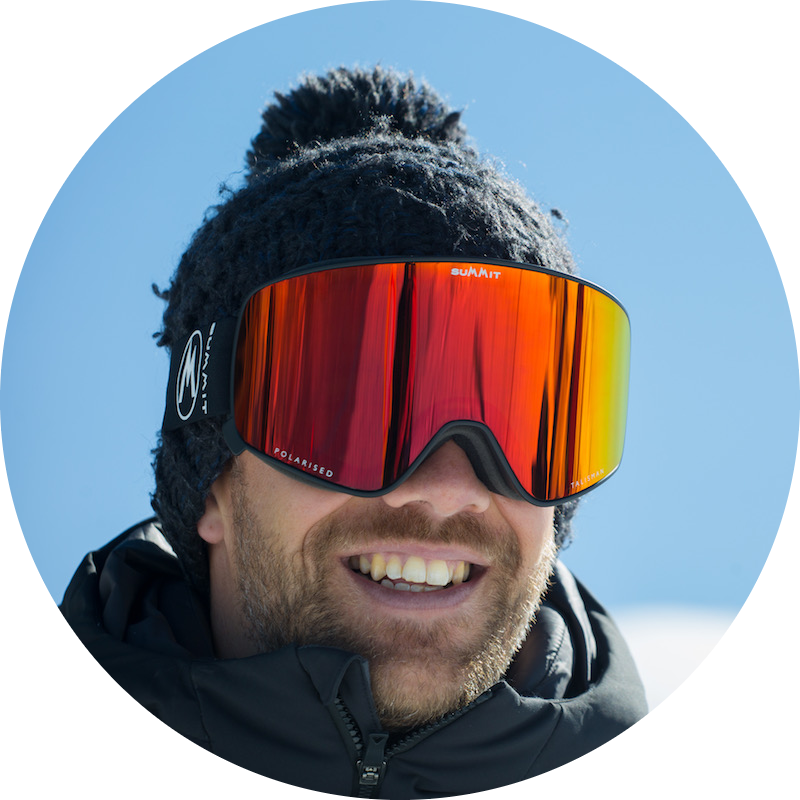
Summit Talisman Ski Goggle with magnetic lens change system (Cylindrical lens)
Spherical Lens Goggles
Spherical lenses have a convex shape that curves on both a horizontal and vertical axis, mirroring the shape of the eye. Spherical lenses provide a wide over-all field of view with very little optical distortion.The shape of spherical lenses provide an equal distance between the eyes and the lens, which can help reduce eye fatigue during extended periods of use. We have released four spherical lens goggles since our inception: Xpose I, Xpose II, Xpose IIs and Evolve.
Spherical Lens Goggles

Summit Xpose II Ski Goggles with magnetic lens change system (Spherical lens)
Anti–fog Coating
Nowadays, the majority of ski goggles come with a double-layered lens which reduces fogging. Anti-fog coating is effective on the inside of the goggles and we advise not rubbing the inside of your lenses to maintain its integrity. Summit Xpose II and Talisman both have an everlasting anti-fog technology which is embedded into the lens, meaning it can’t be rubbed off.
Scratch-resistant coating
Unfortunately it’s impossible to fully protect the exterior coatings of ski goggles and as someone starting out, the chances of your lenses getting scratched, I’m sorry to say, are greatly increased. Being a little clumsy as you fine tune your motor skills is all 100% natural and part of your journey. Watch out for your ski poles, other peoples flailing skis and the chairlift foot rest being lowered as you head back up the mountain. All very common places where lenses become damaged. That all said, a scratch resistant coating will of course help protect your lenses, its a must have.
What does visible light transmission (VLT) mean for ski goggles?
VLT is the amount of light that can pass through a lens. Visible light transmission (VLT) is measured as a percentage of light able to pass through. It’s affected by various factors like lens colour, thickness, coatings and lens material.
- Category 0: over 80% of light passes through the lens. Suitable for night skiing.
- Category 1: between 43% and 80% of light passes through the lens. Ideal for bad weather and foggy conditions. The lens is tinted yellow or pink (rose).
- Category 2: 43% to 18% of light passes through the lens. These lenses are suitable for cloudy conditions or if you ski in the shade.
- Category 3: 8% to 18% of light passes through the lens, making it suitable for use in sunny conditions.
- Category 4: less than 8% of visible light passes through the lens. This category is used for extreme luminosity at high altitudes or on a glacier.
In Summery…
The comfort of goggles is absolute paramount, as you’re going to be wearing them most of the day. They must fit perfectly, with no gaps between the foam and your face. The strap should be wide, adjustable and must fit over your helmet without causing pressure points. The cylindrical or spherical lenses need to have some form of anti-fog coating and offer 100% UV protection from harmful UV rays.
As you are going to experience different weather conditions, the light conditions are ever changing, from stunning clear blue skies to flat light, where you have little contrast or depth perception. For sunny conditions, we recommend using a darkly tinted category 3 mirrored lenses. For snowy and flat light conditions, use a category 1 low-light lens. Your low-light lens will be fairly transparent to let lots of light in and will normally be coloured yellow or pink (rose). These colours help to boost contrast and help to highlight bumps and undulations. We advise not wearing your low light lens in bright conditions, as it’ll cause strain on your eyes leading to headaches.
Your ski goggle lenses need to have quick lens change system. Weather in the mountains has the potential to change very quickly and ski goggle frames become very inflexible when cold. You don’t want to be in a position where you need to change lenses quickly, but are stuck trying to install your low-light lens. Trust us, we learnt this lesson with our first goggle design, Xpose I.
Final thoughts…
If you’re starting out, unless you’re feeling flush, there’s really no need to be buying super expensive ski or snowboard goggles, as they’ll only get damaged. You can pick up an incredible pair of goggles with interchangeable lenses from a reputable brand for around the £100 mark. Naturally you’ll be pretty clumsy when starting out and lenses are likely to get scratched in the lift queue, getting on the chair lift itself, or when they’re left on your helmet at lunch… and let’s not forget when you’re dancing on the table at apres!
With this in mind, check how much it will cost to replace your ski goggle lens should damage occur.
There are various options on the market, but we believe the best option is to have two lenses. A low-light lens (VLT = 43%-80%) and a bright light lens (VLT = 8%-18%). This way when the snowy weather comes in, you have a dedicated low-light lens that is designed to handle low-light conditions. Likewise, when it’s a stunning bluebird day, you have a dedicated bright light lens. As a beginner, you don’t want to be worrying about how to change your lens, which is why we recommend and offer ski goggles with magnetic lens change technology.
At Summit we provide some of the best mens ski goggles and best womens ski goggles available and aim to provide the perfect solution for our clients, whether they are complete beginner just about to encounter the beautiful slopes for the first time, or a seasoned pro. We want you to know that when your pair of goggles arrive that they are going to perform exactly how you need them to and that you have, not just the right lens, but the best technology to change lenses seamlessly so you can adapt to the weather conditions without fuss.
Summit ski goggles come complete with two lenses as standard. This enables our users to switch lenses to suit the ever changing conditions and when in conjunction with our magnetic lens change system, this lens switch is instant!
Thanks for reading and as ever, thanks for your incredibly loyal support,
Simon and Francesca



